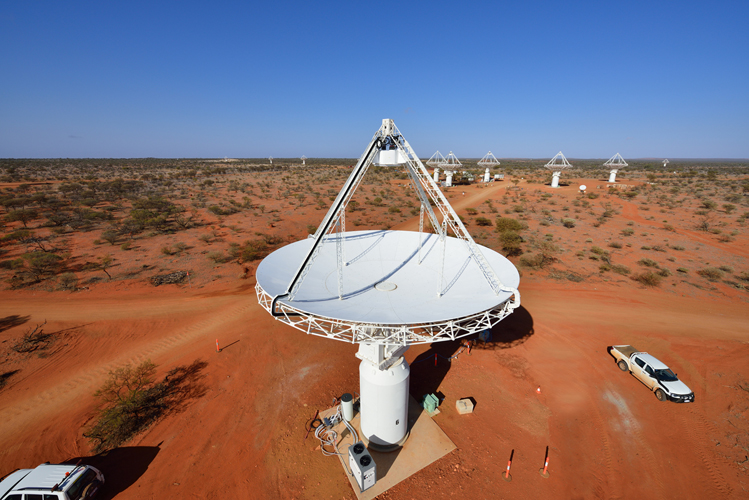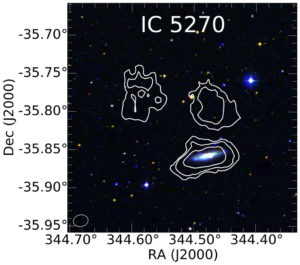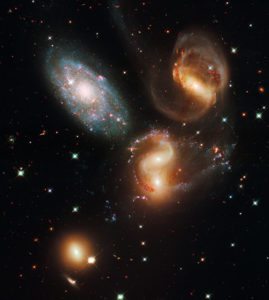
An elevated view of our ASKAP antennas at the Murchison Radio-astronomy Observatory. Credit: CSIRO.
By Helen Sim
It’s been a long journey, but the first scientific results from our Australian SKA Pathfinder telescope are being unveiled in Melbourne this week.
Carried out with six ASKAP antennas used by the team for commissioning activities, these early results have been written up and will appear as scientific papers over the coming months. But astronomers at the OzSKA meeting are getting a sneak peek.
Three key results promise success for some of the big projects planned for ASKAP.
Dark clouds, silver lining
In the first project, CSIRO astronomer Paolo Serra and his colleagues have found that a galaxy called IC 5270 has a couple of shady companions.
They appear to be dark (starless) clouds of hydrogen gas (HI), each with more than a billion solar masses of the stuff. In fact the clouds account for a third of the total HI mass associated with IC 5270.
It’s likely that this gas was stripped out of IC 5270 by gravity when other galaxies passed close by.
Dark clouds of gas (the two upper blobs) near the galaxy IC 5270.
Dark clouds like the ones near IC 5270 have been found before. But the finding is important for ASKAP’s forthcoming WALLABY survey, which is designed to detect HI over three-quarters of the sky and so study how galaxies evolve. It shows that WALLABY will have the sensitivity and resolution to establish (or rule out) evidence for gas stripping for thousands of galaxies, giving us a better handle on how galaxies change over time.
A part-time pulsar
Another team, led by CSIRO astronomer George Hobbs, has been using ASKAP to follow up an unusual pulsar (one of those small, spinning stars that produce regular radio pulsars).
This pulsar, called J1107–5907, spends a good deal of its time ‘turned off’, or at least not producing pulses that we can detect.
Hobbs’ team observed the sky around the pulsar for 13 hours, taking a snapshot every two minutes. The data were processed with a ‘pipeline’ developed for a survey of transient sources, rather than the processing software usually used for pulsar surveys.
J1107–5907 showed up nicely, suggesting that ASKAP’s going to be an ideal telescope for discovering these part-time pulsars. But the way to find them will be with a survey for transient sources, such as VAST (Variables and Slow Transients — one of ten large ASKAP Survey Science projects planned for ASKAP), not a traditional pulsar survey that looks for a regular train of pulses.
Only a few intermittent pulsars are known but many more may be waiting to be discovered.
A well-behaved pulsar (animation). Credit: CAASTRO / Swinburne Astronomy Productions.
Dip shows galaxies are down the road
A third piece of work has shown that ASKAP will be able to detect galaxies other telescopes can’t.
A team led by CSIRO’s James Allison detected a five-billion-year-old radio signal from the distant galaxy PKS B1740-517. Stamped on it is the ‘imprint’ of hydrogen gas (HI) that it travelled through on its way to Earth. This gas absorbs some of the original radio emission, creating a little dip or nick in the signal.
The dip is tiny and at many observatories there is so much radio ‘noise’ that it wouldn’t be seen. But ASKAP’s home, the Murchison Radio-astronomy Observatory, is so beautifully ‘radio quiet’ that the dip stands out clearly.
Most galaxies have lots of HI and these absorption dips are an excellent way to detect them. The trouble has been knowing where to look, especially how far out. But the signal from PKS B1740-517 was found in a ‘blind’ (unguided) search, which opens up the whole field.
In particular, it means that one of ASKAP’s forthcoming large surveys, FLASH (First Large Absorption Survey in HI), is set to find thousands of galaxies. Moreover, they’ll be ones that are five to eight billion years old. These should help us understand why the rate of star formation in the Universe fell after its peak ten billion years ago.
If you’re interested in finding out more of what the astronomy community is talking about this week at the OzSKA meeting, follow along on Twitter using #OzSKA or see the CAASTRO site for more detail.
.@RayPNorris drops a few teasers on ASKAP science talks coming up over the next few days at #ozska
— CSIRO_ATNF (@CSIRO_ATNF) April 8, 2015




9th April 2015 at 9:41 pm
SKA? Mm wonder what that stands for? What do you reckon kids? Scientific …. something Association?
9th February 2017 at 7:44 pm
Try Square Kilomter Array (ven though its not that big yet)
9th April 2015 at 6:43 pm
Dear CSIRO,
A respectful request:
Please add Google+ and LinkedIn sharing buttons to your post ( see: https://en.support.wordpress.com/sharing/ ).
Thank you kindly.
9th April 2015 at 4:54 pm
You can’t assume folks casually exploring for information will have grasped the ASKAP acronym. There will ALWAYS (not an acronym) be newbies. We need fresh enthusiasts. Demystify the CAPs.
9th April 2015 at 5:13 pm
Thanks for your feedback mizminh. The first acronym has been expanded with more detail, and hyperlinks are provided for those wanting to find out further information.